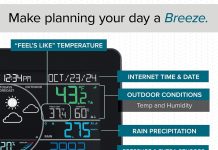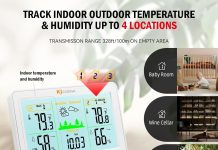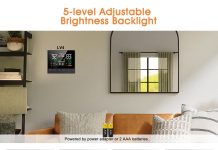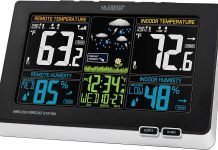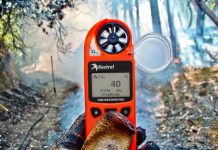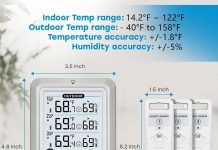When it comes to comparing home weather stations, there are a few key factors that we should keep in mind. Accuracy is crucial, as we want a device that will provide reliable data to help us plan our day. Ease of use is also important, as we want a weather station that won’t require a degree in meteorology to navigate. And of course, pricing plays a role too, as we want to find a device that fits within our budget. So, let’s explore the world of home weather stations and discover what we should be looking for.
Review contents
Accuracy
When comparing home weather stations, one of the most important factors to consider is accuracy. After all, what good is a weather station if it can’t provide reliable and precise measurements? There are several aspects to consider when evaluating the accuracy of a weather station.
Sensor Precision
The precision of the sensors used in a weather station is crucial for obtaining accurate measurements. Look for weather stations that use high-quality sensors with fine-tuned precision. These sensors should be able to capture even the slightest changes in temperature, humidity, barometric pressure, wind speed, and rainfall.
Calibration
To ensure accurate readings, it is essential to calibrate the sensors regularly. Calibration involves adjusting the readings of the sensors to match a known reference value. Some weather stations offer automatic calibration features, while others require manual calibration. Consider whether the weather station you are considering offers easy calibration options to maintain accuracy.
Data Refresh Rate
The data refresh rate refers to how frequently the weather station updates its readings. A faster refresh rate allows for real-time monitoring and offers more up-to-date information. Look for weather stations that have a high data refresh rate, ensuring that you have the most current data available. This is particularly important if you need to monitor rapidly changing weather conditions or rely on accurate and timely information for activities like gardening or outdoor events.
Sensor Types
Different weather conditions require different sensors to accurately measure and monitor them. When comparing home weather stations, consider the types of sensors they offer and whether they align with your specific needs.
Temperature
Temperature sensors are a standard component of any weather station. These sensors measure the ambient temperature and provide crucial data for tracking weather patterns and determining appropriate clothing or heating and cooling needs. Look for weather stations that offer temperature sensors with a wide operating range and high accuracy to get reliable temperature readings.
Humidity
Humidity sensors measure the amount of moisture in the air. They are essential for understanding comfort levels, monitoring potential mold and mildew growth, and predicting weather patterns. Look for weather stations that feature humidity sensors capable of accurately measuring both indoor and outdoor humidity levels.
Barometric Pressure
Barometric pressure sensors measure the atmospheric pressure, which helps predict short-term weather changes. By monitoring barometric pressure trends, you can anticipate shifts in weather conditions, such as storms or changes in air pressure. Look for weather stations with accurate barometric pressure sensors to ensure reliable weather predictions.
Wind Speed and Direction
Wind sensors measure both the speed and direction of the wind. These sensors are crucial for understanding wind patterns, especially for activities such as sailing, outdoor sports, or planning outdoor events. Look for weather stations that offer wind speed and direction sensors that provide precise readings and can withstand various weather conditions.
Rainfall
Rain sensors measure the amount of rainfall over a specific period. They are essential for gardeners, farmers, and anyone interested in tracking precipitation. Look for weather stations that include accurate rainfall sensors capable of measuring different intensities of rainfall.
Wireless Connectivity
The ability to access and monitor weather data remotely is a significant advantage of modern home weather stations. Therefore, it’s important to consider the wireless connectivity options offered by different weather station models.
Range
Consider the range of the wireless connectivity when comparing weather stations. The range determines how far away you can be from the weather station while still being able to access data. If you want to monitor the weather conditions in your backyard, for example, ensure that the weather station’s wireless range covers the distance between your desired monitoring location and your home.
Interference
Since most weather stations transmit data wirelessly, it’s important to consider potential interference issues. Look for weather stations that utilize wireless technologies with strong interference resistance. This will help prevent signal disruptions that can compromise data transmission and remote accessibility.
Compatibility
Check the compatibility of the weather station with different devices and platforms. Some weather stations offer dedicated smartphone apps, allowing you to conveniently access weather data on your mobile device. Others may integrate with popular smart home systems, providing seamless integration into your existing home automation setup. Consider the compatibility options that align with your preferences and technology ecosystem.
Data Display
An intuitive and visually appealing data display is crucial for easily interpreting the weather information provided by a home weather station.
Indoor and Outdoor Readings
Look for weather stations that provide clear and separate displays for both indoor and outdoor readings. This allows you to easily distinguish between the two and monitor the conditions in multiple locations. The displays should show the current values of temperature, humidity, barometric pressure, wind speed, rainfall, and any other sensors included in the weather station.
Graphs and Charts
In addition to current readings, visual representations such as graphs and charts can help you analyze trends and patterns over time. Look for weather stations that offer graphing capabilities, allowing you to track temperature, humidity, and other variables over hours, days, weeks, or months.
Forecasting
Weather stations that provide forecasting capabilities are a valuable addition. These stations use historical data and advanced algorithms to predict weather patterns, giving you a glimpse into what lies ahead. Check if the weather station offers accurate and reliable forecast information to help you plan your activities and make informed decisions based on anticipated weather conditions.
Power Source
Consider the power source options offered by weather stations, as they directly impact their functionality and convenience.
Battery Life
If you prefer a wireless and portable weather station, pay attention to the battery life. Look for weather stations that offer long-lasting battery life, ensuring that you can rely on continuous operation without frequent battery changes or recharges. Consider whether the weather station requires standard or rechargeable batteries and evaluate the associated convenience and cost factors.
Backup Options
In case of power outages or battery drain, it’s beneficial to have backup power options for your weather station. Look for weather stations that offer backup power through options like solar panels or the ability to connect to an external power source. These backup options ensure that your weather station continues to provide data even during periods of power disruption.
Installation and Mounting
The ease of installation and mounting options are essential considerations, especially if you plan to set up the weather station yourself.
Ease of Installation
Look for weather stations that offer straightforward installation procedures, typically with easy-to-follow instructions or user-friendly setup guides. These stations should allow for quick and hassle-free installation, even for those with limited technical knowledge. Consider whether the weather station requires professional assistance or extra tools for installation.
Mounting Options
Consider the mounting options provided by the weather station. Some models come with versatile mounting kits that allow you to attach them to different surfaces, such as walls, fences, or poles. Evaluate whether the mounting options align with your specific location requirements and ensure stability and durability for long-term use.
Cable Management
Weather stations often require cable connections between different components. Pay attention to the cable management system provided by the weather station. Look for weather stations that offer smart cable management solutions, such as cable clips or channels, to keep the installation neat and organized. These features help prevent cable damage and ensure a tidy appearance.
Data Logging and Storage
The ability to log and store weather data is crucial for long-term analysis and reference purposes. Consider the data logging and storage capabilities of different weather stations.
Storage Capacity
Different weather stations offer varying levels of data storage capacity. Evaluate how much data a weather station can store internally and determine whether the capacity aligns with your requirements. Look for weather stations that either offer large internal storage or allow for expandable external storage options, such as SD cards or cloud-based solutions.
Data Access
Consider how accessible the logged data is from the weather station. Look for weather stations that provide convenient ways to access and transfer data. Some stations offer USB ports, Wi-Fi connectivity, or options to sync with cloud storage platforms, allowing you to easily retrieve and analyze the data on your preferred devices or applications.
Alerts and Notifications
Weather stations with alert and notification features help keep you informed about significant weather changes or events.
Extreme Weather Alerts
Look for weather stations that offer the ability to set up alerts for extreme weather conditions. These alerts can notify you when weather conditions reach predefined thresholds. Whether it’s a temperature drop, strong winds, or heavy rainfall, these alerts can help you take appropriate actions to protect yourself, your property, and your plants.
Customizable Notifications
Evaluate whether the weather station allows you to customize notifications according to your specific needs. Some weather stations allow you to choose which weather parameters trigger notifications and define the desired notification methods, such as push notifications on your smartphone or email alerts. Customizable notifications ensure that you receive relevant and timely information based on your preferences.
Additional Features
Several additional features can enhance the functionality and convenience of a home weather station.
UV Index Measurement
An important feature for those concerned about sun exposure is the ability to measure the UV index. Look for weather stations that include UV sensors and display the UV index alongside other weather parameters. This feature helps you understand the strength of the sun’s ultraviolet rays and take appropriate measures to protect your skin.
Solar Radiation Measurement
If you are involved in activities like gardening or solar panel installations, measuring solar radiation becomes crucial. Look for weather stations that offer solar radiation sensors, allowing you to monitor the amount of solar energy received at a given location. This information assists in optimizing plant growth or maximizing the efficiency of solar power systems.
Smart Home Integration
If you have a smart home setup, consider weather stations that offer integration with popular smart home platforms. This integration allows you to incorporate weather data into your existing automation routines. For example, you can automate shades or blinds based on the amount of sunlight, turn on sprinklers based on rainfall, or adjust the thermostat based on temperature changes.
Mobile App
Many weather stations offer dedicated mobile apps that enable easy access to weather data from your smartphone or tablet. Look for weather stations that provide well-designed and user-friendly mobile apps with intuitive interfaces, real-time data updates, and additional features like customizable notifications or remote control options. Evaluate the availability and compatibility of the app with your preferred mobile operating system.
Remote Access
Having the ability to remotely access your weather station’s data is a convenient feature. Look for weather stations that offer remote access options, such as web portals or mobile apps connected to cloud-based data storage. This feature allows you to check weather conditions or view historical data even when you are away from home.
Price and Warranty
Finally, consider the price range and warranty coverage when comparing home weather stations.
Price Range
Weather station prices can vary significantly depending on the brand, features, and quality. Determine your budget and evaluate the price range of weather stations that meet your requirements. Remember to consider the value provided by each station in terms of accuracy, features, and durability.
Warranty Coverage
Check the warranty coverage offered by different weather station manufacturers. A good warranty ensures that you are protected against any potential manufacturing defects or malfunctions. Look for weather stations with generous warranty periods, preferably with customer support that is responsive and helpful. This way, you can have peace of mind knowing that your investment is protected.
In conclusion, when comparing home weather stations, accuracy, sensor types, wireless connectivity, data display options, power sources, installation and mounting features, data logging and storage capabilities, alerts and notifications, additional features, price, and warranty coverage must be considered. By evaluating each of these aspects, you can select a weather station that best suits your needs and provides you with accurate, reliable, and comprehensive weather information.




